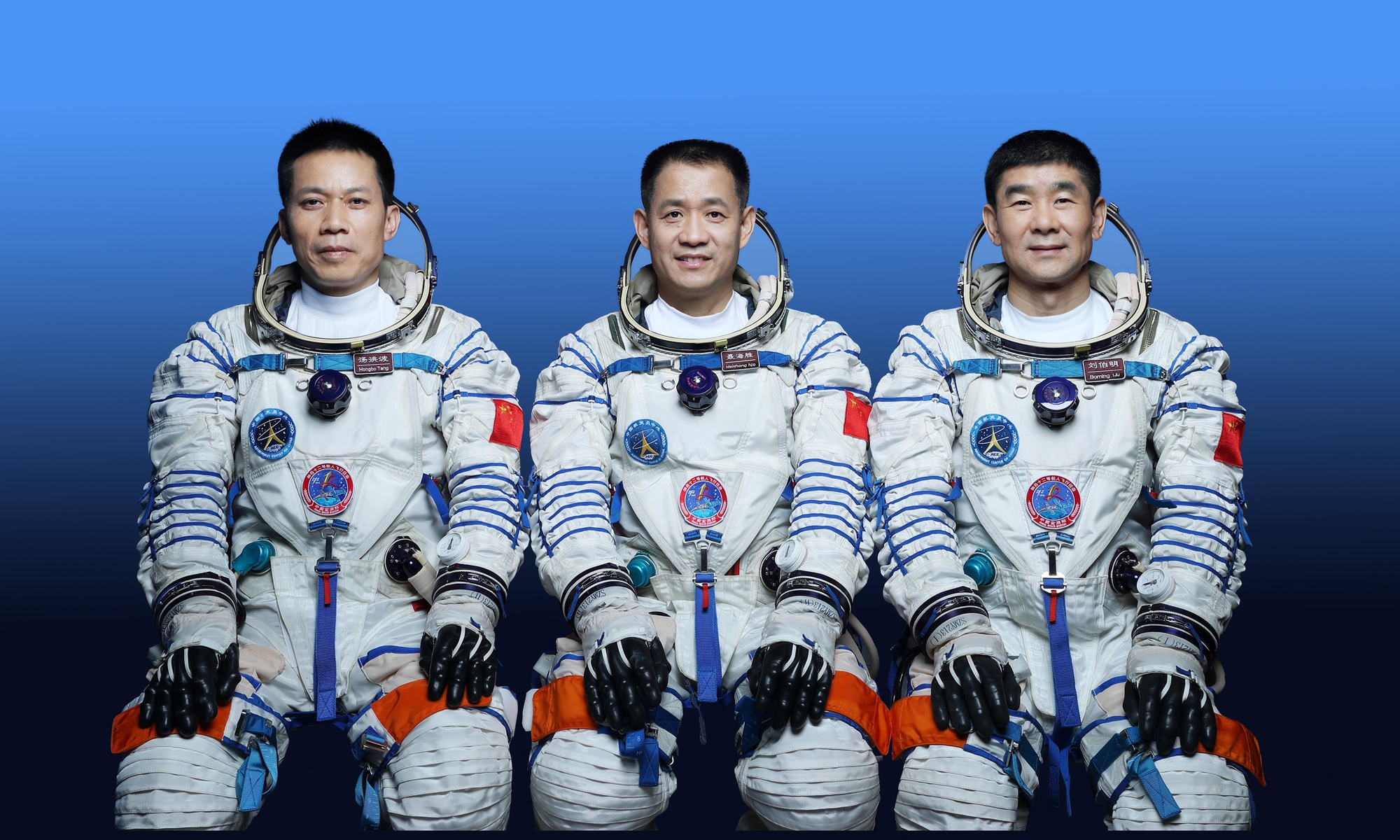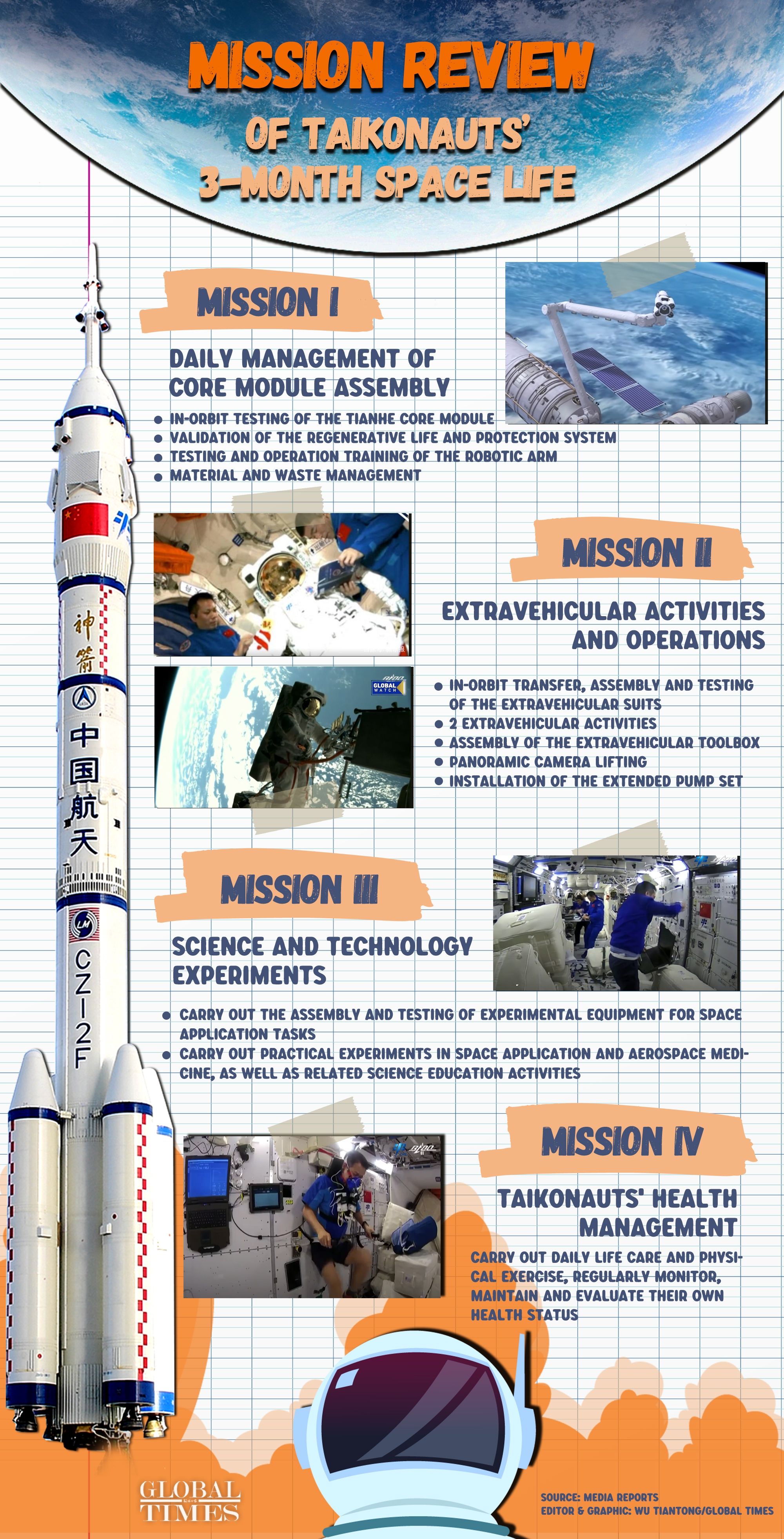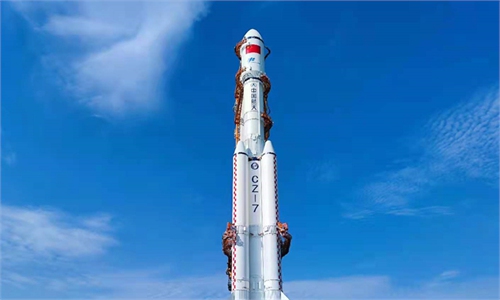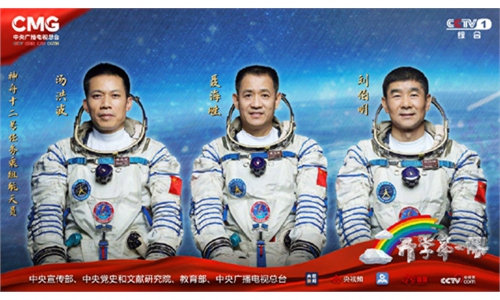Shenzhou-12 taikonauts ready to return to Earth ahead of China's Moon Festival after record-long stay in orbit

Shenzhou-12's crew (from left) Tang Hongbo, Nie Haisheng and Liu Boming Photo:CMSA
With the Mid-Autumn Festival - one of the most important family reunion occasions for Chinese people - just around the corner, China's space heroes are also coming home.
With a crew of three taikonauts, Shenzhou-12 manned spacecraft successfully separated with China's Tianhe space station core module on Thursday morning, before its planned return to Earth on Friday. Having lived and worked in orbit for 90 days, the crew has set a new record of longest space stay in a single flight for Chinese astronauts.
Before the separation, the crew completed a range of tasks including transmitting experiment data back to Earth in addition to sorting and transferring of goods which are to remain in orbit, with the help of technicians on the ground, the Global Times learned from the China Manned Space Agency (CMSA) on Thursday.
Before the taikonauts left their space villa, they had to pack all equipment and attach it to the cabin to prevent it from creating damage if left unrestrained. They also transferred all supplies and equipment inside the Tianzhou-2 cargo spaceship into the Tianhe core cabin, as the Tianzhou-2 will soon detach with Tianhe.
Following the separation, Shenzhou-12 crew had another important task to complete - verification of vertical rendezvous and docking technology. Shenzhou-12 is expected to go around the Tianhe core module and make a U-turn to fly to the back and below of Tianhe, before it raises its head and uplifts itself into an upright position vertical to the space station, state broadcaster China Central Television (CCTV) reported on Thursday.
According to the CMSA, the Shenzhou-12 manned spacecraft managed to pull off the feat as of 1:38 pm on Thursday, laying the ground for follow-up Shenzhou-13 manned flight mission.
"Vertical docking is a very challenging task that only the Shenzhou manned spacecraft series can complete," CCTV reported. "So that's why the Shenzhou-12 needs to sort things out in advance."
The returned capsule of the Shenzohu-12 craft is expected to touch down in the designated Dongfeng landing site that is adjacent to the Jiuquan Satellite Launch Center in the Gobi Desert in North China's Inner Mongolia Autonomous Region. The Jiuquan center is also where the manned mission started on June 17. The CMSA updated later on Thursday that the Shenzhou-12 will return to Earth on Friday.
Mission insiders explained that the Dongfeng site usually serves as a backup landing site to the traditional Siziwang Banner site. The reason behind the change is due to the location the taikonauts are coming back from. Returning from a space station can be different than from a spaceship. It's harder for the land crew to calculate the exact landing point. So, landing in the desert is a safer option.
In May last year, the Dongfeng landing site received the capsule of the trial version of new-generation manned spacecraft, which carried out a flight that took two days and 19 hours to complete, the Global Times reported.
During their 90-day stay in orbit, Shenzhou-12 mission commander Nie Haisheng and his fellow crew members Liu Boming and Tang Hongbo carried out a variety of tasks, including transferring and unboxing supplies from Tianzhou-2 cargo spacecraft to decorate the space station core module, and conducting hours-long spectacular spacewalks twice, verifying the reliability of the craft's smart robotic arm.
As the first group of residents in the Chinese space villa, they also verified the capability of the new regenerative life support systems onboard, laying foundation for future missions and the long-term operation of China's space station.
And above all, they inspired the Chinese people from space. The three-month mission has left numerous great moments for the Chinese public, with highlights such as sending congratulations from space on the centenary of the Communist Party of China on July 1 and tutoring a scientific lesson from space on September 1 when schools across the country were about to start a new semester.
The three also conducted space-ground chat with students in Hong Kong on September 3, introducing their daily life and work as well as experiments they have conducted in space, drawing rounds of cheers and awes from a thrilled audience.
Tang's vlogs describing their daily work and life in space and Liu Boming's amazing snaps of Earth also gained millions of views and thumbs-up from all over the world.
In an exclusive interview with the Global Times, Cui Guangzhi, a leading scientist with the 206 Research Institute of the Second Academy of the China Aerospace Science and Industry Corp (CASIC) which devised the urine treatment system, said that the system has processed some 600 liters of urine into over 500 liters of water during the Shenzhou-12 crew's three-month stay.
The developers told the Global Times that this is the nation's first engineering application of the system, and its impressive performance shows how China's space station technology has advanced.
Parts of the system that suffered wear during the period in space and samples of the taikonauts' urine will return to Earth together with them for further study. The future Tianzhou-3 cargo spacecraft will carry replacement parts for the system and the Shenzhou-13 crew will carry out installation to ensure the system will work in the best operation status, according to Cui.
According to the CMSA, the combo of Tianzhou-3 cargo spacecraft and Long March-7 Y4 carrier rocket has been rolled out to a launching pad in the Wenchang Space Launch Center in South China's Hainan Province on Thursday.
The facility at the space port is in good shape with all pre-launch tests underway, the agency revealed.

Mission review of Taikonauts' 3-month space life Graphic: Wu Tiantong/GT



